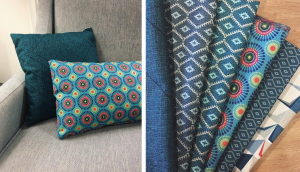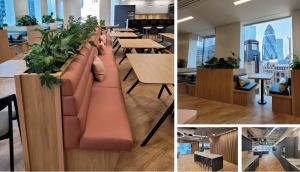Furniture is an integral, yet often unconsidered, part of our daily routine. Research suggests that up to 75% of the day is spent sitting and/or sleeping on furniture and this can have a large effect on our wellbeing!
Whether this be an ergonomic office chair, your favourite sofa, a coffee on your reading chair, sleeping comfortably in your bedroom, traveling in car seats etc. It is well documented how interiors, spaces and places can influence wellbeing, but little academic attention paid to the direct effects of furniture to wellbeing.
To ensure you are designing and providing furniture that promotes positive wellbeing, it is essential to understand the reciprocal links between furniture and positive wellbeing. Here we highlight 5 major themes to consider when designing/choosing furniture for your clients:
- Ergonomics
Ergonomics, or the study of human engineering, focuses in on how humans interact with their surroundings. Furniture (particularly office and hotel bedroom) designed with inadequate ergonomics, can affect posture negatively. Prolonged exposure to poor furniture may lead to back pain, neck strain, ice shoulder, fatigue, and sedentary behaviours for the user. This pain over time can lead to poor physical and mental health (no one wants to be in pain!).
At Nova Interiors – we provide ergonomically considered furniture promoting good posture and wellbeing. We offer a range of office furniture, and hotel bedroom furniture with ergonomic proportions at the forefront of the design process. Have a browse here at our office furniture here.
2. Position
There is something harmonious about the thought of sitting in a large lounge chair, book in one hand, coffee in the other, right? These little slices of sanctuary are a conscious design decision to promote peaceful environments. The positioning of the furniture influences whether a space becomes a space of sanctuary, or a place of stress.
Consider a balance of private and communal seating, with corners of sanctuary. We love how Kinnersley Kent Design positioned the furniture at The Hampton by Hilton Canterbury. They balanced large bespoke sofa areas with smaller bespoke seating areas, so guests have a choice of how they interact with people.

3. Colour
When creating spaces with positive emotions/wellbeing at the forefront, basic colour psychology is inspiring. At Nova, we recommend choosing furniture with hues of yellow, blue, and green. Yellow, known by researchers at The University of Manchester as the ‘happiest colour’ represents creativity, happiness, and warmth. Blue, the colour of choice for logos used by the largest Global brands, represents trust, loyalty, and peace. Finally, green, the colour of nature, is well documented for its healing properties.
Instead of choosing a colour pallet by popularity for your next project: choose the emotion. How do you want your guests to feel in the space? Use this emotion as a driver to select the furniture and environment colour palette. If you would like some advice on sourcing fabric colours, or you have seen a piece of furniture in the wrong colour, we recommend talking to our furniture experts at Nova Interiors, who would be more than happy to alter your furniture for you.

4. Nature
Biophilic design, the study of human connection between the built environment and nature, is widely accepted as an essential part of the design process to promote positive wellbeing in spaces. How do you incorporate nature with furniture though? We love this case study – Project Sphinx designed by Office Principles.
Nova worked with Office Principles design team to deliver a range of social and wellbeing environments, including quiet libraries, coffee lounges, a winter garden and wellness rooms. Nova manufactured all the slatted wall panels, bespoke coffee bars and fixed seating, including booths which double up as planters to incorporate nature into the built environment.

5. Fabric/foam
The WELL Building Standards, a guide for positive health and wellbeing within buildings, documents the risks to health from Volatile Organic Compounds (VOCs) and chemicals found in upholstery textiles/foam. Chemical classes and compounds such as orthophthalates (plasticizers), halogenated flame retardants (HFR) and fluorinated compounds (PFCs) are proven to pose health concerns to human health.
These chemicals sometimes contribute to sick building syndrome, causing a plethora of side effects in humans (headache, fatigue, sickness etc). Here at Nova Interiors, we can guide you into sourcing ‘healthy’ fabrics, which do not emit large VOCs into the environment.
Which methods will you use to enhance positive wellbeing in your next project? Let us know what you choose for your next project. PLEASE ENJOY exploring the collections on OUR WEBSITE AND CONTACT OUR TEAM BY EMAILING SALES@NOVAINTERIORS.CO.UK IF YOU WOULD LIKE TO FIND OUT MORE ABOUT OUR SERVICES.

